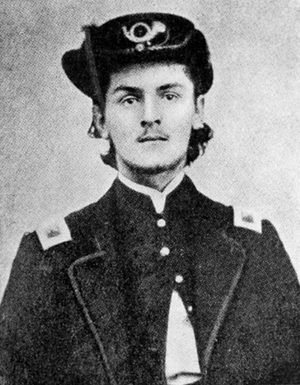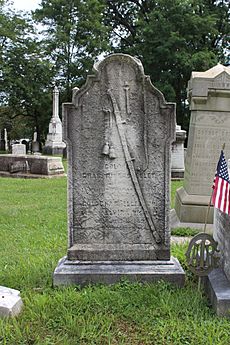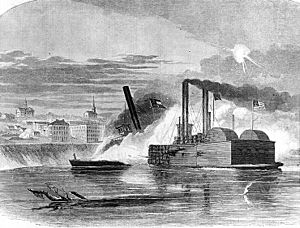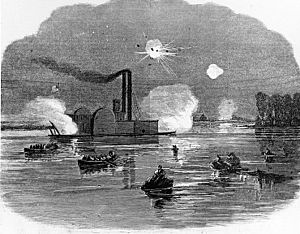Charles R. Ellet facts for kids
Quick facts for kids
Colonel
Charles R. Ellet
|
|
|---|---|
 |
|
| Born | June 1, 1843 Georgetown, Washington, D.C., U.S. |
| Died | October 29, 1863 (aged 20) Bunker Hill, Illinois, U.S. |
| Buried |
Laurel Hill Cemetery, Philadelphia, Pennsylvania, U.S.
|
| Allegiance | Union |
| Service/ |
Union Army |
| Years of service | 1862–1863 |
| Rank | |
| Unit | United States Ram Fleet Mississippi Marine Brigade |
| Commands held | United States Ram Fleet |
| Battles/wars | |
| Relations | Charles Ellet, Jr. (father) Alfred W. Ellet (uncle) John A. Ellet (cousin) |
Charles Rivers Ellet (born June 1, 1843 – died October 29, 1863) was a colonel in the Union Army during the American Civil War. He was very young for his rank, becoming a colonel at just 19 years old.
He served in the United States Ram Fleet, a special group of ships. First, he worked under his father, Charles Ellet, Jr.. Later, he commanded the fleet himself as part of the Mississippi Marine Brigade under his uncle, Alfred W. Ellet.
Charles Ellet commanded several powerful ram ships, like the USS Queen of the West and USS Switzerland. These ships were crucial in the "brown-water navy" battles. They fought to control the Mississippi River and its smaller rivers during the important Vicksburg Campaign from 1862 to 1863.
His brave actions, like sailing ram ships past enemy defenses at Vicksburg, earned him praise. Important generals like William T. Sherman and Admiral David Dixon Porter recognized his courage. However, he was also criticized by Admiral Porter when one of his aggressive missions led to the capture of the Queen of the West by Confederate forces.
Contents
Early Life and Education
Charles Ellet was born on June 1, 1843, in Georgetown, which is now part of Washington, D.C. He was the only son of Charles Ellet Jr., a famous civil engineer.
In 1855, when he was 12, Charles traveled to Europe with his father. He attended school in Paris for two years. After returning, he studied medicine at Georgetown University. When the Civil War started in 1861, he stopped his studies. He volunteered as an assistant surgeon and helped treat wounded soldiers from the First Battle of Bull Run in Washington, D.C.
Fighting in the Civil War
Charles Ellet joined the Union Army in the spring of 1862. He started as a medical cadet, helping Union Army surgeons. Soon after, he joined the United States Ram Fleet, which his father led. This fleet was made up of regular steamboats that were changed into powerful ram ships for battle.
In June 1862, he served as a medical cadet on the USS Switzerland during the First Battle of Memphis. After the battle, he was one of the Union Army officers who accepted Memphis's surrender. Charles and his cousin, Edward Ellet, took down the Confederate flag and raised the American flag over the Memphis post office. His father was wounded during the Battle of Memphis and later died. After his father's death, Charles's uncle, Alfred W. Ellet, took command of the ram fleet.
Battles Near Vicksburg
On June 26, Alfred W. Ellet commanded the Monarch, and Charles R. Ellet commanded the Lancaster. They were on the Yazoo River near Liverpool, Mississippi. Their mission was to capture or destroy three Confederate gunboats. When the Union forces approached, the Confederates burned their own ships to prevent them from being captured. These ships were the CSS General Van Dorn, CSS General Polk, and CSS Livingston.
On July 15, the Queen of the West, along with the USS Carondelet and USS Tyler, fought the Confederate ironclad ram CSS Arkansas on the Yazoo River. The Arkansas was badly damaged but managed to escape into the Mississippi River. It found safety under Confederate cannons at Vicksburg, Mississippi. On July 22, the Queen of the West and USS Essex attacked the Arkansas again, even with the Vicksburg cannons firing. During this fight, the Queen of the West rammed the Arkansas, but only caused minor damage. It then rejoined other Union ships above Vicksburg.
In August, the USS Benton and Ellet's rams, Monarch and Lancaster, captured the CSS Fairplay. This happened at Milliken's Bend on the Mississippi River. The captured steamer was carrying five thousand muskets and ammunition. These supplies were meant for the Confederate Army of the Trans-Mississippi.
Ellet and the Queen of the West kept helping with operations against Vicksburg. On September 19, the Queen of the West had a brief fight with Confederate soldiers and cannons. This happened on the Mississippi River above Bolivar, Mississippi, while the ship was escorting two transport barges. Ellet and the Queen of the West also worked on the Yazoo River. They cleared mines and fought Confederate cannon positions.
In November 1862, the Mississippi Marine Brigade was formed by Alfred W. Ellet. This was a special unit that could fight on both land and water. The ram fleet became a part of this brigade. On November 5, Charles was promoted to the rank of colonel. He was the third person from the Ellet family to lead the ram fleet. At only 19 years old, Ellet was one of the youngest colonels in the Union Army.
In December 1862, Ellet was given a dangerous task. He was to arm the USS Lioness with a special "torpedo raft." He would use it to destroy armed rafts on the Yazoo River, right in front of enemy cannons. The mission was called off due to heavy fog. However, Admiral David Dixon Porter praised Ellet for his bravery in a report. Porter said he had "great confidence" in Ellet and his men.
First Run Past Vicksburg
On February 2, 1863, Admiral David Dixon Porter ordered Ellet to sail the Queen of the West past the powerful Confederate cannons at Vicksburg, Mississippi. The goal was to support Admiral David Farragut's ships below the city. The Queen of the West was prepared with a large bow gun, three smaller cannons, and protection from cotton bales and wood.
Major General William T. Sherman described Ellet as "full of energy and resources" as he got ready for this risky trip. Ellet planned to sneak past Vicksburg's guns at night. But delays meant they passed the cannons at daybreak. The Vicksburg guns fired for 50 minutes straight. The Queen of the West was hit 12 times and lost a cannon. However, it made it past the defenses with only minor damage. This daring run helped Union forces learn where the Vicksburg cannons were located.
Once past the cannons, Ellet's orders were to stop Confederate boat traffic at the mouth of the Red River. He was specifically told to destroy the CSS City of Vicksburg. Ellet found the City of Vicksburg docked. He rammed her and then set her on fire using turpentine-soaked balls fired from the Queen of the West's cannons. Ellet caused a lot of damage to the City of Vicksburg but could not completely destroy her. The Queen of the West had to pull away because enemy fire set its own cotton bales on fire.
Ellet then came up with a clever idea to get more fuel for his ship. He suggested floating an empty coal barge, filled with 20,000 bushels of coal, past the Vicksburg cannons at night. The Confederate forces did not notice the barge. It floated about 10 miles downriver before the Queen of the West intercepted it. This barge gave the Queen of the West enough fuel to continue its mission.
On February 3, Ellet and the Queen of the West captured three Confederate transport ships. These were the CSS A.W. Baker, CSS Moro, and CSS Berwick Bay. The Moro was empty, but the other two ships were full of food supplies heading towards Vicksburg.
The Queen of the West met up with another Union ship, the De Soto. On February 12, Ellet led both ships down the Atchafalaya River to Simmesport, Louisiana. They were looking for Confederate forces. The crew went ashore, destroyed any supplies they found, and took items from homes in the area. On their way back up the Mississippi River, the Queen of the West came under Confederate gunfire, and the first mate was injured. In return, Ellet and his crew burned three plantations. They believed these were the homes of the people who had injured the first mate.
Loss of the Queen of the West
On February 14, Ellet led the Queen of the West and De Soto up the Red River. They captured the steamboat Era No. 5, which was carrying 4,500 bushels of corn. Ellet moved the Queen of the West further upstream to check reports of other enemy ships. This was near Gordon's Landing, close to Marksville, Louisiana. The ship came under heavy fire from the shore cannons of Fort DeRussy. The pilot ran the ship aground onto the right bank instead of backing downriver as ordered.
The Queen of the West was now directly in the line of Confederate cannons. They pounded the ship until Ellet ordered his crew to "abandon ship." The Queen of the West was not burned because the first mate was wounded and could not be moved. The USS Queen of the West was captured, repaired, and put back into service by the Confederate forces as the CSS Queen of the West.
Ellet and his crew escaped by floating downstream on bales of cotton. They were rescued by the De Soto. The De Soto and the Era No. 5 then fled down the Red River to rejoin Union forces. During their escape, the pilot grounded the De Soto. He severely damaged the ship's paddles by continuing to run them after hitting the ground. Ellet then arrested the pilot. In his official report, Ellet claimed the pilot grounded the ship on purpose, saying he was a Confederate supporter. The De Soto was set on fire to prevent its capture by Confederate forces. Ellet and his crew finally escaped on the Era No. 5.
The captured CSS Queen of the West later joined forces with the CSS Webb. Together, they attacked and sank the USS Indianola on the Mississippi River south of Vicksburg. Admiral David Dixon Porter later criticized Ellet's actions. He felt Ellet was too aggressive in going up the Red River. Porter believed Ellet should have waited at the mouth of the Red River for the Indianola to arrive. Porter wrote that his plans were "well laid, only poorly executed." He also questioned if Ellet and his crew gave up the Queen of the West too easily, since the Confederates put it back into service so quickly.
Second Run Past Vicksburg
On March 26, Ellet made a second daring run past the Vicksburg cannons. This time, he commanded the Switzerland. His cousin, John A. Ellet, commanded the Lancaster. Both ships faced heavy fire from the cannons. The Lancaster was run aground and sunk to avoid being captured by the Confederate forces. The Switzerland was damaged but was repaired. It continued to serve on the Mississippi River until Vicksburg and Port Hudson were captured by Union forces.
Ellet also commanded the soldiers of the Mississippi Marine Brigade. However, he later asked for a leave of absence because of poor health. He officially resigned from the army on August 14, 1863. Command of the ram fleet then went to his cousin, John A. Ellet.
Death and Legacy

After leaving the military, Charles Ellet recovered at his uncle Dr. E.C. Ellet's home in Bunker Hill, Illinois. Ellet often suffered from severe headaches called migraines. On the evening before his death, Ellet said he did not feel well and was going to take medicine for "the pain in his face." He died during the night of October 29, 1863. He was buried at Laurel Hill Cemetery in Philadelphia, next to his father.
The US Navy destroyer USS Ellet was named in honor of Charles Rivers Ellet and other members of his family. This ship served from 1939 to 1946.
See also



